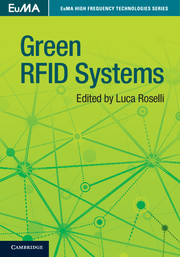Book contents
- Frontmatter
- Contents
- List of contributors
- Introduction
- 1 Context analysis
- 2 RFID background
- 3 Energy scavenging and storage for RFID systems
- 4 Technologies for RFID sensors and sensor tags
- 5 Unconventional RFID systems
- 6 Integrating tiny RFID- and NFC-based sensors with the Internet
- 7 Materials for substrates
- 8 Organic conductors and semiconductors: recent achievements and modeling
- 9 RFID enabling new solutions
- 10 Energy-efficient off-body communication using textile antennas
- Index
- References
10 - Energy-efficient off-body communication using textile antennas
Published online by Cambridge University Press: 05 October 2014
- Frontmatter
- Contents
- List of contributors
- Introduction
- 1 Context analysis
- 2 RFID background
- 3 Energy scavenging and storage for RFID systems
- 4 Technologies for RFID sensors and sensor tags
- 5 Unconventional RFID systems
- 6 Integrating tiny RFID- and NFC-based sensors with the Internet
- 7 Materials for substrates
- 8 Organic conductors and semiconductors: recent achievements and modeling
- 9 RFID enabling new solutions
- 10 Energy-efficient off-body communication using textile antennas
- Index
- References
Summary
Introduction
Wearable RFID systems should be low-profile, lightweight, flexible, and breathable, in order not to hinder the user’s body movements. Planar textile antennas are a perfect choice for integration into clothing as they meet all the above requirements. Moreover, textile antennas are composed of environmentally friendly materials.
Exploiting the large platform garments have to offer, multiple antennas are readily implemented onto the human body. The high radiation efficiency of the proposed textile antennas, combined with a multi-antenna setup, provides a solution to the “energy problem” by creating very reliable communication links at a low transmitted power. Therefore, textile antennas are an excellent choice for green RFID applications.
Multi-antenna systems increase communication reliability using several techniques. A MIMO technique such as space–time block coding provides diversity gain, which mitigates the effects of fading by the environment. The use of dual-polarized textile antennas doubles the number of exploitable signal paths for an equal number of antenna patches on the body. Beam forming techniques can concentrate the transmitted power towards the receiver, which potentially results in a performance increase for an off-body RFID system at a reduced cost, compared to space–time coding techniques for transmit diversity used in MIMO systems.
- Type
- Chapter
- Information
- Green RFID Systems , pp. 248 - 267Publisher: Cambridge University PressPrint publication year: 2014



